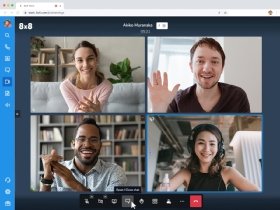
kantver - Fotolia
8x8 pushes work collaboration through a browser
8x8 said offering its Work apps through browsers helps companies prepare for the hybrid workplace by allowing workers to use the devices at hand to collaborate.
8x8 has made its Work for Web communication platform available to more customers and improved its Meet video conferencing software. The latest updates move customers closer to online collaboration through a web browser instead of a separate app.
The company announced the enhancements on Tuesday, saying browser-based communication tools let people work from a much broader variety of devices, a necessity in the hybrid workplace.
8x8 Work for Web is the browser-based version of Work. The latter is a platform that provides voice communications, video meetings and chat. With Work for Web, employees can access the same services from Google Chrome or Microsoft Edge browsers on Chrome OS, Linux, macOS or Windows computers. Work desktop is available on only Windows PCs and Macs.
Work for Web had been available in private beta since early 2021. As of this week, the beta is to all customers, except those on the basic plan.
Raúl Castañón-Martínez, an analyst at 451 Research, said collaborating in browsers is a trend in the unified communications market. Vendors like Microsoft, Cisco and Zoom enable workers to participate in video meetings without downloading an app.

"There are several benefits for IT organizations [with this approach], such as not having to deal with downloading and supporting additional applications on end-user devices," he said.
Mobile users can also take part in 8x8 Meet video meetings without downloading an app. The company said workers with iOS or Android devices could join discussions from their Safari or Chrome browsers.
8x8 announced other features as well. Video meeting participants can customize their backgrounds for sessions, a capability that other platforms have had for some time. Also, workers can silence incoming calls during meetings.
In team chat, employees can use inline replies to respond directly to a chat message. Motorists can send and receive messages by voice with Android Auto and Google Assistant. During voice calls, a call quality indicator helps participants diagnose audio problems.
Mike Gleason is a reporter covering unified communications and collaboration tools. He previously covered communities in the MetroWest region of Massachusetts for the Milford Daily News, Walpole Times, Sharon Advocate and Medfield Press. He has also worked for newspapers in central Massachusetts and southwestern Vermont and served as a local editor for Patch. He can be found on Twitter at @MGleason_TT.







